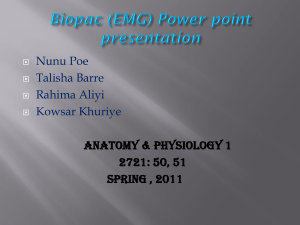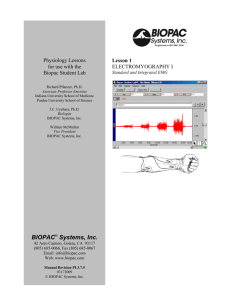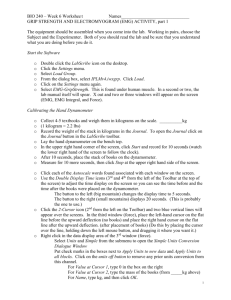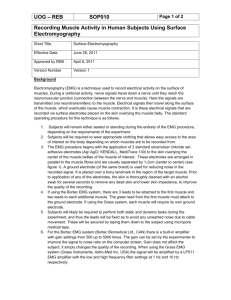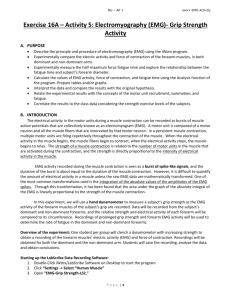Lesson 1 ELECTROMYOGRAPHY 1 Motor Unit Recruitment
advertisement
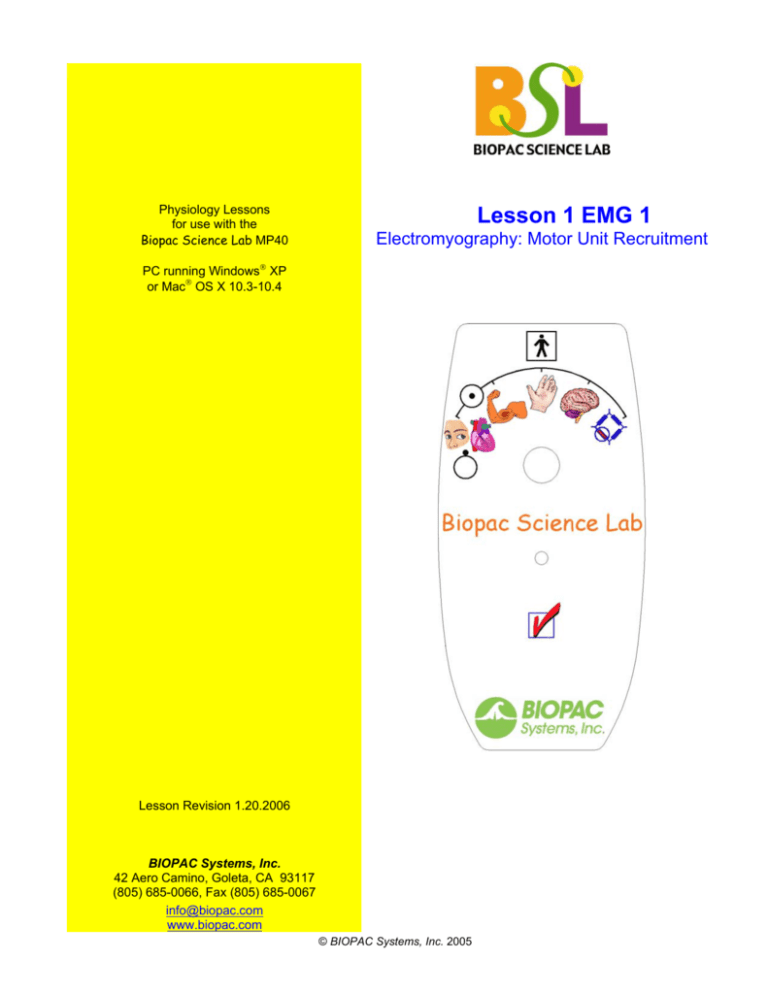
Physiology Lessons for use with the Biopac Science Lab MP40 Lesson 1 EMG 1 Electromyography: Motor Unit Recruitment PC running Windows® XP or Mac® OS X 10.3-10.4 Lesson Revision 1.20.2006 BIOPAC Systems, Inc. 42 Aero Camino, Goleta, CA 93117 (805) 685-0066, Fax (805) 685-0067 info@biopac.com www.biopac.com © BIOPAC Systems, Inc. 2005 Biopac Science Lab Page 2 Lesson 1 ELECTROMYOGRAPHY 1 Motor Unit Recruitment I. SCIENTIFIC PRINCIPLES y p o e t C a c i w l e up i v Re ot D N o D Skeletal muscles are attached to the skeleton and produce movements such as in walking, jogging, or lifting weights. The strength of a skeletal muscle’s contraction, or the amount of force the muscle develops when it shortens, is graded and depends on the workload placed on the muscle. For example, the force of muscle contraction required to lift a 5 kg weight is less than the force required to lift a 25 kg weight, and the effort of muscles used in walking on level ground is less than the effort those same muscles expend in climbing stairs. Physiologically, the strength of a skeletal muscle’s contraction is subconsciously adjusted by the brain, which controls the number of actively shortening muscle fibers and their degree of shortening. A skeletal muscle is made up of thousands of individual long cylindrically-shaped cells called fibers. Each muscle fiber is supplied by a single motor nerve fiber that initiates and controls the contraction of the muscle fiber. One motor nerve fiber controls several muscle fibers simultaneously. The motor nerve fiber and all of the muscle fibers it controls is called a motor unit (Fig. 1.1). One method the brain uses to increase the strength of skeletal muscle contraction when required is to increase the number of simultaneously active motor units. This process is known as motor unit recruitment. Another way the brain can increase the strength of a skeletal muscle’s contraction is to increase the frequency of nerve impulses traveling in each motor nerve fiber. An increase in motor nerve fiber frequency increases the degree of shortening in each active motor unit, enabling the muscle to perform an increased amount of work. Fig. 1.1 y p o e t C a c i w l e p i v u e R ot D N Do When skeletal muscles are resting and appear to be not actively shortening, they nonetheless maintain a slight state of contraction and internal tension known as tonus. Tonus is due to alternate periodic activation of a small number of motor units within the muscle by control centers in the brain and spinal cord, and serves to maintain the muscle in a state of readiness. When a motor unit is activated, the component muscle fibers generate and conduct their own electrical impulses that ultimately result in contraction of the fibers. Although the electrical impulse generated and conducted by each fiber is very weak (less than 100 microvolts), many fibers conducting simultaneously induce voltage differences in the overlying skin that are large enough to be detected by a pair of surface electrodes. The detection, amplification, and recording of changes in skin voltage produced by underlying skeletal muscle contraction is called electromyography. The recording thus obtained is called an electromyogram (EMG). II. EXPERIMENTAL OBJECTIVES 1) To record maximum clench strength for right and left hands. 2) To observe, record, and correlate motor unit recruitment with increased power of skeletal muscle contraction 3) Optional: To listen to EMG “sounds” and correlate sound intensity with motor unit recruitment. III. MATERIALS Biopac Science Lab system (MP40 and software) on computer running Windows XP or Mac OS X Electrode lead set (40EL lead set) Disposable vinyl electrodes (EL503), six electrodes per subject Optional: Headphones (40HP) to listen to the EMG signal Lesson 1: EEG 1 Page 3 IV. EXPERIMENTAL METHODS A. Set Up Equipment y p o e t C a c i w l e up i v Re ot D N o D Subject Fig. 1.3 Electrode connections for each arm Fig. 1.2 MP40 with 40EL connected FAST TRACK Details 1. Turn the computer ON. 2. Set the MP40 dial to OFF. 3. Plug the equipment in as follows: Electrode leads (40EL) Æ MP40 Optional: Headphones (40HP) Æ computer Connect stereo headphones (40HP) to the computer to prepare for the optional “Listening to EMG” segment. 4. Attach three electrodes to each arm as shown To detect grip muscle EMGs, attach electrodes to each anterior forearm and wrist as shown in Fig. 1.3. in Fig. 1.3. 5. Connect the electrode leads (40EL) to the For optimal electrode response, place electrodes on the electrodes on the Subject’s dominant arm, skin at least five minutes before starting the lesson. matching lead color to electrode position as shown in Fig. 1.3. For the first recording segment, connect the leads to the Subject’s dominant arm (generally the right arm if the Subject is IMPORTANT right-handed, or the left arm if the Subject is left-handed); this Clip each electrode lead color to its will be Forearm 1. specified electrode position. y p o e t C a c i w l e p i v u e R ot D N Do Use the Subject’s non-dominant arm for the second recording segment, labeled Forearm 2. Each pinch connector on the end of the electrode cable needs to be attached to a specific electrode. Follow the color code above to ensure that each cable is connected to the proper electrode. 6. Start the Biopac Science Lab software. 7. Choose lesson L01-EMG-1 and click OK. 8. Type in a unique file name. 9. Click OK. No two people can have the same file name, so use a unique identifier, such as the Subject’s nickname or student ID#. This ends the Set Up procedure. © BIOPAC Systems, Inc. 2005 Biopac Science Lab Page 4 B. Check Details FAST TRACK MP40 Check y p o e t C a c i w l e up i v Re ot D N o D 1. Set the MP40 dial to 2. Press and hold the MP40. 3. Click EMG (high). Check pad on the when the light is flashing. 4. Wait for the MP40 check to stop. Continue to hold the pad down until prompted to let go. 5. Let go of the Check pad. 6. Click Continue. The MP40 check procedure will last five seconds. The light should stop flashing when you let go of the Check pad. When the light stops flashing, click Continue. Signal Check 7. 8. 9. 10. 11. Click Check Signal. Click OK. After two seconds, clench and release. Wait for the Signal Check to stop. Review the data. If correct, go to the Record section. If incorrect, click . After two seconds, clench your hand as hard as possible (Fig. 1.4) and then relax your hand. y p o e t C a c i w l e p i v u e R ot D N Do Fig. 1.4 The eight-second Signal Check recording should resemble Fig.1.5. Fig. 1.5 If the recording check does not show a burst of activity for the hand clench, click Redo Signal Check. Lesson 1: EEG 1 Page 5 C. Record Details Watch the Help menu videos to prepare for the recording. You will record one segment on each arm. Segment 1: dominant Segment 2: non-dominant In order to work efficiently, read this entire section so you will know what to do before recording. Stop each recording segment as soon as possible so you don’t waste recording time (time is memory). FAST TRACK 1. Prepare for the recording. y p o e t C a c i w l e up i v Re ot D N o D SEGMENT 1 2. Click When you click Record, the recording will begin and an append marker labeled Forearm 1 will automatically be inserted. During recording, you can visually review the EMG and Integrated EMG signals. . 3. Complete four cycles of clench-hold-release with increasing clench force. Clench fist and hold for two seconds, release the clench and wait for two seconds. Repeat for three more cycles with increased clench force until the maximum clench is achieved. Try to increase the strength in equal increments such that the fourth clench is the maximum force. 4. Click Suspend. When you click Suspend, the recording will halt, giving you time to review the data and prepare for the next recording segment. 5. Review the data. If correct, go to Step 6. If incorrect, click Redo. The data should resemble Fig. 1.6. The data should show multiple peaks for each clench, each with greater amplitude than the preceding clench. y p o e t C a c i w l e p i v u e R ot D N Do Fig. 1.6 Motor unit recruitment—clenching with increased force If the data does not match, click Redo and repeat Steps 2-5; the last data segment you recorded will be erased. SEGMENT 2 6. To record Forearm 2, switch the leads to the electrodes on the Subject’s other forearm (per Set Up Steps 4 and 5). 7. Click Resume. A marker labeled Forearm 2 will automatically be inserted when you click Resume, and the recording will continue from the point it left off. 8. Complete four cycles of clench-hold-release with increasing clench force. Clench fist and hold for two seconds, release the clench and wait for two seconds. Repeat for three more cycles with increased clench force until the maximum clench is achieved. Try to increase the strength in equal increments such that the fourth clench is the maximum force. © BIOPAC Systems, Inc. 2005 Biopac Science Lab Page 6 9. Click Suspend. When you click Suspend, the recording will halt, giving you time to review the data. 10. Review the data. If correct, go to Step 11. If incorrect, click Redo. The data should resemble Fig. 1.6. The data should show multiple peaks for each clench, each with greater amplitude than the preceding clench. If the data is incorrect, have the Subject rest so the arm muscles recover and data will be meaningful. When ready, click Redo and repeat Steps 7-10; the last data segment you recorded will be erased. 11. Optional: Click Resume to record additional segments. Optional: You can record additional segments by clicking Resume instead of Done. A time marker will be inserted at the start of each added segment. 12. Click Stop. A pop-up window with options will appear. Click Yes (or No if you want to redo the last segment). y p o e t C a c i w l e up i v Re ot D N o D 13. Click Yes. SEGMENT 3 — Optional: Listening to EMG 14. If you want to listen to the EMG signal: Put on the headphones Click Listen; or To end the recording, go to Step 17. Listening to the EMG is optional. Listening to the EMG can be a valuable tool in detecting muscle abnormalities and is performed here for general interest. Note When the Listen button is clicked, the volume through the headphones may be very loud due to system feedback. The volume cannot be adjusted, so you may have to position the headphones slightly off the ear to reduce the sound. 15. Subject must clench hard and release to optimize the signal for the listening segment. y p o e t C a c i w l e p i v u e R ot D N Do 16. As anyone listens, Subject should change the clench force. Watch how the data changes. Listen to the sound variation. 17. Click Stop to end the listening segment. 18. Click Done to end the lesson. 19. Choose an option and click OK. 20. Remove the electrodes. END OF RECORDING You will hear the EMG signal through the headphones as it is being displayed on the screen. The screen will display two channels: CH1 EMG, and CH40 Integrated EMG. The data on the screen will not be saved. The signal will run until you click Stop. If others in your lab group would like to hear the EMG signal, pass the headphones around and click Redo. When you click Done, a dialog with options will be generated. Make your choice, and click OK. If you choose Analyze current data file, go to the Analyze section for directions. Unclip the electrode lead connectors and peel off the electrodes. Throw out the electrodes. Lesson 1: EEG 1 Page 7 V. ANALYZE FAST TRACK Details 1. Enter the Review Saved Data mode and choose the correct file. To review saved data, choose Analyze current data file from the Done dialog after recording data, or choose Review Saved Data from the Lessons menu and browse to the required file. y p o e t C a c i w l e up i v Re ot D N o D Note Channel Number (CH) designations: Channel Displays CH1 EMG (raw signal) CH40 Integrated EMG Fig. 1.7 2. Set up the measurement boxes as follows: Channel Measurement CH1 Min CH1 Max CH1 P-P CH40 Mean The measurement boxes are above the marker region in the data window. Each measurement has three sections: channel number, measurement type, and result. The first two sections are pull-down menus that are activated when you click them. The following is a brief description of specific measurements. Min: displays the minimum value in the selected area. Max: displays the maximum amplitude value within the selected area (including the endpoints). P-P: Peak-to-Peak shows the difference between the maximum amplitude value in the selected range and the minimum amplitude value in the selected range. Mean: displays the average value in the selected area. Note The “selected area” is the area selected by the IBeam tool (including the endpoints). You can record measurement data individually by hand or choose Edit > Journal > Paste measurement to paste the data to your journal for future reference. y p o e t C a c i w l e p i v u e R ot D N Do Analysis continues… © BIOPAC Systems, Inc. 2005 Biopac Science Lab Page 8 3. Set up the display window for optimal viewing of the first data segment. Fig. 1.8 shows a sample display of the first data segment recorded using the Subject’s dominant forearm. The following tools help you adjust the data window: Autoscale Horizontal Horizontal (Time) Scroll Bar Autoscale Waveforms Vertical (Amplitude) Scroll Bar Zoom Overlap button Zoom Previous/Back Split button y p o e t C a c i w l e up i v Re ot D N o D Fig. 1.8 EMG cluster Note “Clusters” are the EMG bursts associated with each clench. A sample cluster is selected in the figure above. 4. Using the I-Beam tool, select an area enclosing the first EMG cluster. A y p o e t C a c i w l e p i v u e R ot D N Do 5. Repeat Step 4 on each successive EMG cluster. A 6. Scroll to the second recording segment. 7. Repeat Steps 4-5 for the Forearm 2 data. The second recording segment begins at the marker labeled Forearm 2 and represents the non-dominant arm. 8. Scroll to the first recording segment and select Tonus is the resting state and is represented by the area areas of tonus (between clenches) for Forearm between clenches (clusters). Measure for Forearm 1, the 1, the dominant arm. dominant arm. C 9. Scroll to the second recording segment and select areas of tonus (between clenches) for Forearm 2, the non-dominant arm. C 10. Save or print the data file. 11. Exit the program. 12. Set the MP40 dial to Off. Tonus is the resting state and is represented by the area between clenches (clusters). Measure for Forearm 2, the nondominant arm. You may save the data, save notes that are in the journal, or print the data file. END OF LESSON 1 Complete the Lesson 1 Data Report that follows. Biopac Science Lab Lesson 1 Page 9 EMG 1 These are sample questions. You should amend, add, or delete questions to support your curriculum objectives. Motor Unit Recruitment DATA REPORT y p o e t C a c i w l e up i v Re ot D N o D Student’s Name: Lab Section: Date: I. Data and Calculations Subject Profile Name Age Gender: Male / Female Height Dominant forearm: Right / Left Weight EMG Measurement A. Complete the table with data from your recordings. Table 1.1 Cluster # Min [CH1] Forearm 1 (Dominant) Max P-P Mean [CH1] [CH1] [CH40] Min [CH1] Forearm 2 Max P-P [CH1] [CH1] Mean [CH40] 1 2 3 4 Note “Clusters” are the EMG bursts associated with each clench. y p o e t C a c i w l e p i v u e R ot D N Do Mean Measurements B. Use the mean measurement from the table above to compute the percentage increase in EMG activity recorded between the weakest clench and the strongest clench of Forearm 1. Calculation: Answer: __________________% Tonus Measurements C. Complete the following table with data from your recordings. Table 1.2 Cluster # 1 2 3 Forearm 1 (Dominant) P-P Mean [CH1] [CH40] P-P [CH1] Forearm 2 Mean [CH40] 4 5 © BIOPAC Systems, Inc. 2005 Biopac Science Lab Page 10 II. Data Summary and Questions D. Compare the mean measurement for the right and left maximum-clench EMG cluster. Are they the same or different? ________ Same ________ Different y p o e t C a c i w l e up i v Re ot D N o D Which one suggests the greater clench strength? ________ Right ________ Left ________ Neither Explain. E. What factors in addition to gender greatly contribute to observed differences in clench strength? F. Does there appear to be any difference in tonus between the two forearm clench muscles? ____ Yes ____ No Would you expect to see a difference? Does the Subject’s gender influence your expectations? Explain. G. Explain the source of signals detected by the EMG electrodes. H. Define motor unit recruitment. I. Define skeletal muscle tonus. J. Define electromyography. y p o e t C a c i w l e p i v u e R ot D N Do End of Biopac Science Lab Lesson 1 Data Report VI. ACTIVE LEARNING LAB Design a new experiment to test or verify the scientific principle(s) you learned in the Biopac Science Lab recording and analysis segments. y p o e t C a c i w l e up i v Re ot D N o D For this lesson, you might examine how different positions or muscle groups influence max force. Design Your Experiment Use a separate sheet to detail your experiment design, and be sure to address these main points: A. Hypothesis Describe the scientific principle to be tested or verified. B. Materials List the materials will you use to complete your investigation. C. Method Describe the experimental procedure—be sure to number each step to make it easy to follow during recording. See the Set Up section or Help > About Electrodes for electrode placement guidelines. Run Your Experiment D. Set Up Set up the equipment and prepare the subject for your experiment. y p o e t C a c i w l e p i v u e R ot D N Do E. Record Use the Record, Resume, and Suspend buttons in the Biopac Science Lab program to record as many segments as necessary for your experiment. Click Done when you have completed all of the segments required for your experiment. Analyze Your Experiment F. Set measurements relevant to your experiment and record the results in a Data Report. © BIOPAC Systems, Inc. 2005
